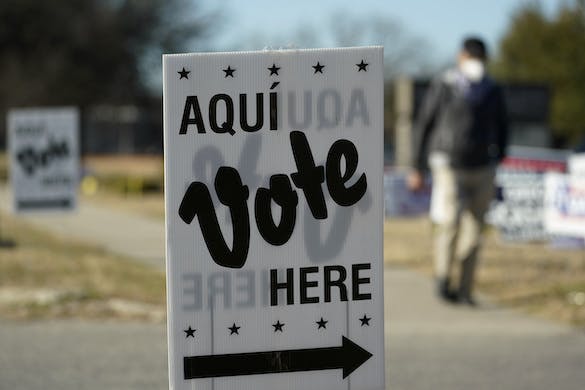Latino Support for Democrats Craters Since Last Midterms
New polling suggests that Hispanic and Latino voters are becoming less loyal to Democrats.

A recent poll suggests that support for Democrats among Latino voters has cratered since the last midterm election in 2018, with the two main parties now virtually tied in a demographic that Democrats dominated by nearly 40 points four years ago.
Republicans, however, can take solace only there. The GOP is struggling among other key demographics, and it’s too soon to tell how the latest findings might affect the midterm elections in November.
The CBS/YouGov poll released Sunday finds that Republicans have nearly closed the gap since 2018, garnering 42 percent approval among Hispanics compared to the Democrats’ 45 percent. The margin of error means the poll is statistically a tie.
This polling bolsters the conventional wisdom that Hispanic and Latino voters are, while not necessarily abandoning the Democrats as a voting bloc, becoming much less loyal to them.
In 2018, Democrats carried nearly 70 percent of the Hispanic vote, defeating Republicans by 40 points among Hispanic and Latino voters, according to Pew Research. In 2020, President Biden carried nearly 60 percent of the Latino vote.
The GOP also is struggling in other demographics, such as women and voters under 30, according to the CBS/YouGov poll.
Among women, the GOP trails Democrats by 10 points. Current polling suggests that they are not preparing to vote Republican in 2022, even though the GOP increased its support among women in 2020. During the 2018 midterms, according to Pew, Democrats enjoyed a 16-point advantage over GOP candidates.
Republicans are struggling even more among voters under age 30, with less than one-quarter of likely voters telling pollsters that they support the GOP compared to two-thirds who say they support Democrats.
In 2018, according to the Tufts Tisch College Center for Information and Research on Civic Learning and Engagement, 67 percent of young voters voted for Democrats compared to 32 percent who voted for Republicans.
While voter turnout tends to be lower among younger voters, turnout there increased between 2016 and 2020. Millennials in particular are accounting for an increasingly large portion of the electorate, after becoming the largest generation of voting age in 2019.
The one thing that everyone seems to agree on, according to the YouGov poll, is that America is heading the wrong direction, with 78 percent of respondents reporting that they feel things are going “badly” in the country and 70 percent having a negative view of today’s economic conditions.
The economic pessimism likely spells trouble for Democrats as the election approaches, at least according to a professor of political science at Hamilton College, Philip Klinkner.
“In general when the economy is bad people blame the incumbent,” he tells the Sun. “It sure didn’t help Jimmy Carter in 1980.”
Although Americans’ feelings about the economy and their disapproval of Mr. Biden could hurt Democrats, there are enough headwinds for the GOP that 2022 could end up being more competitive than some pundits are predicting, according to the managing editor at Sabato’s Crystal Ball, Kyle Kondik.
“If Democrats do have a better election than history might suggest, it probably will be because they were able to make this election less of a referendum and more of a choice by exploiting vulnerable Republican candidates in key swing states and unpopular Republican positions on key issues like abortion,” Mr. Kondik tells the Sun.

